Zihao Zhu
SCOPE-DTI: Semi-Inductive Dataset Construction and Framework Optimization for Practical Usability Enhancement in Deep Learning-Based Drug Target Interaction Prediction
Mar 12, 2025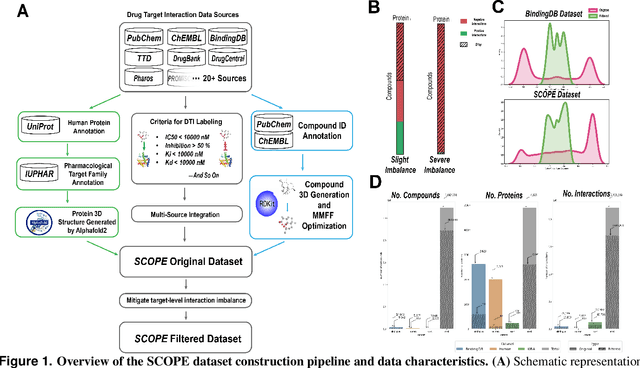

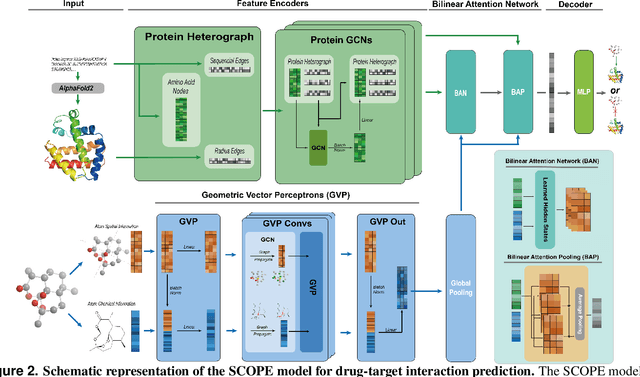
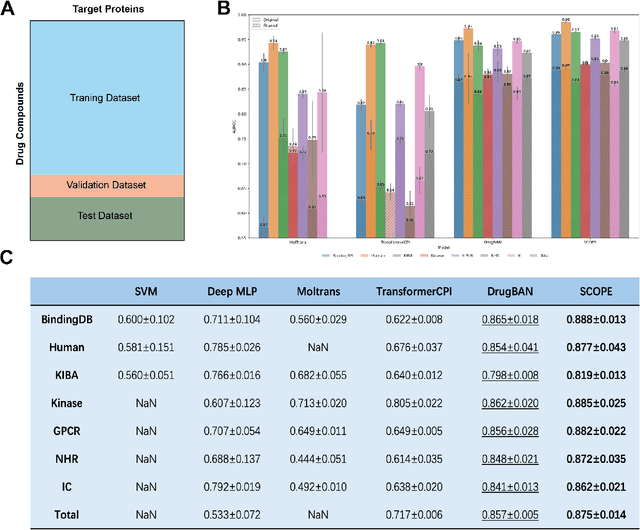
Abstract:Deep learning-based drug-target interaction (DTI) prediction methods have demonstrated strong performance; however, real-world applicability remains constrained by limited data diversity and modeling complexity. To address these challenges, we propose SCOPE-DTI, a unified framework combining a large-scale, balanced semi-inductive human DTI dataset with advanced deep learning modeling. Constructed from 13 public repositories, the SCOPE dataset expands data volume by up to 100-fold compared to common benchmarks such as the Human dataset. The SCOPE model integrates three-dimensional protein and compound representations, graph neural networks, and bilinear attention mechanisms to effectively capture cross domain interaction patterns, significantly outperforming state-of-the-art methods across various DTI prediction tasks. Additionally, SCOPE-DTI provides a user-friendly interface and database. We further validate its effectiveness by experimentally identifying anticancer targets of Ginsenoside Rh1. By offering comprehensive data, advanced modeling, and accessible tools, SCOPE-DTI accelerates drug discovery research.
AuxDepthNet: Real-Time Monocular 3D Object Detection with Depth-Sensitive Features
Jan 07, 2025



Abstract:Monocular 3D object detection is a challenging task in autonomous systems due to the lack of explicit depth information in single-view images. Existing methods often depend on external depth estimators or expensive sensors, which increase computational complexity and hinder real-time performance. To overcome these limitations, we propose AuxDepthNet, an efficient framework for real-time monocular 3D object detection that eliminates the reliance on external depth maps or pre-trained depth models. AuxDepthNet introduces two key components: the Auxiliary Depth Feature (ADF) module, which implicitly learns depth-sensitive features to improve spatial reasoning and computational efficiency, and the Depth Position Mapping (DPM) module, which embeds depth positional information directly into the detection process to enable accurate object localization and 3D bounding box regression. Leveraging the DepthFusion Transformer architecture, AuxDepthNet globally integrates visual and depth-sensitive features through depth-guided interactions, ensuring robust and efficient detection. Extensive experiments on the KITTI dataset show that AuxDepthNet achieves state-of-the-art performance, with $\text{AP}_{3D}$ scores of 24.72\% (Easy), 18.63\% (Moderate), and 15.31\% (Hard), and $\text{AP}_{\text{BEV}}$ scores of 34.11\% (Easy), 25.18\% (Moderate), and 21.90\% (Hard) at an IoU threshold of 0.7.
HMGIE: Hierarchical and Multi-Grained Inconsistency Evaluation for Vision-Language Data Cleansing
Dec 07, 2024Abstract:Visual-textual inconsistency (VTI) evaluation plays a crucial role in cleansing vision-language data. Its main challenges stem from the high variety of image captioning datasets, where differences in content can create a range of inconsistencies (\eg, inconsistencies in scene, entities, entity attributes, entity numbers, entity interactions). Moreover, variations in caption length can introduce inconsistencies at different levels of granularity as well. To tackle these challenges, we design an adaptive evaluation framework, called Hierarchical and Multi-Grained Inconsistency Evaluation (HMGIE), which can provide multi-grained evaluations covering both accuracy and completeness for various image-caption pairs. Specifically, the HMGIE framework is implemented by three consecutive modules. Firstly, the semantic graph generation module converts the image caption to a semantic graph for building a structural representation of all involved semantic items. Then, the hierarchical inconsistency evaluation module provides a progressive evaluation procedure with a dynamic question-answer generation and evaluation strategy guided by the semantic graph, producing a hierarchical inconsistency evaluation graph (HIEG). Finally, the quantitative evaluation module calculates the accuracy and completeness scores based on the HIEG, followed by a natural language explanation about the detection results. Moreover, to verify the efficacy and flexibility of the proposed framework on handling different image captioning datasets, we construct MVTID, an image-caption dataset with diverse types and granularities of inconsistencies. Extensive experiments on MVTID and other benchmark datasets demonstrate the superior performance of the proposed HMGIE to current state-of-the-art methods.
Reliable Poisoned Sample Detection against Backdoor Attacks Enhanced by Sharpness Aware Minimization
Nov 18, 2024



Abstract:Backdoor attack has been considered as a serious security threat to deep neural networks (DNNs). Poisoned sample detection (PSD) that aims at filtering out poisoned samples from an untrustworthy training dataset has shown very promising performance for defending against data poisoning based backdoor attacks. However, we observe that the detection performance of many advanced methods is likely to be unstable when facing weak backdoor attacks, such as low poisoning ratio or weak trigger strength. To further verify this observation, we make a statistical investigation among various backdoor attacks and poisoned sample detections, showing a positive correlation between backdoor effect and detection performance. It inspires us to strengthen the backdoor effect to enhance detection performance. Since we cannot achieve that goal via directly manipulating poisoning ratio or trigger strength, we propose to train one model using the Sharpness-Aware Minimization (SAM) algorithm, rather than the vanilla training algorithm. We also provide both empirical and theoretical analysis about how SAM training strengthens the backdoor effect. Then, this SAM trained model can be seamlessly integrated with any off-the-shelf PSD method that extracts discriminative features from the trained model for detection, called SAM-enhanced PSD. Extensive experiments on several benchmark datasets show the reliable detection performance of the proposed method against both weak and strong backdoor attacks, with significant improvements against various attacks ($+34.38\%$ TPR on average), over the conventional PSD methods (i.e., without SAM enhancement). Overall, this work provides new insights about PSD and proposes a novel approach that can complement existing detection methods, which may inspire more in-depth explorations in this field.
RiskAwareBench: Towards Evaluating Physical Risk Awareness for High-level Planning of LLM-based Embodied Agents
Aug 08, 2024



Abstract:The integration of large language models (LLMs) into robotics significantly enhances the capabilities of embodied agents in understanding and executing complex natural language instructions. However, the unmitigated deployment of LLM-based embodied systems in real-world environments may pose potential physical risks, such as property damage and personal injury. Existing security benchmarks for LLMs overlook risk awareness for LLM-based embodied agents. To address this gap, we propose RiskAwareBench, an automated framework designed to assess physical risks awareness in LLM-based embodied agents. RiskAwareBench consists of four modules: safety tips generation, risky scene generation, plan generation, and evaluation, enabling comprehensive risk assessment with minimal manual intervention. Utilizing this framework, we compile the PhysicalRisk dataset, encompassing diverse scenarios with associated safety tips, observations, and instructions. Extensive experiments reveal that most LLMs exhibit insufficient physical risk awareness, and baseline risk mitigation strategies yield limited enhancement, which emphasizes the urgency and cruciality of improving risk awareness in LLM-based embodied agents in the future.
LoCI-DiffCom: Longitudinal Consistency-Informed Diffusion Model for 3D Infant Brain Image Completion
May 17, 2024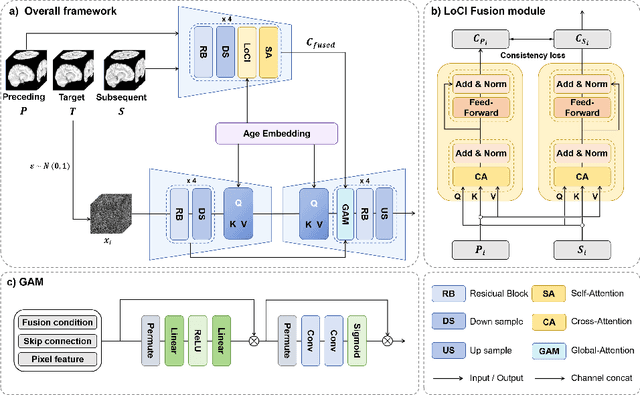
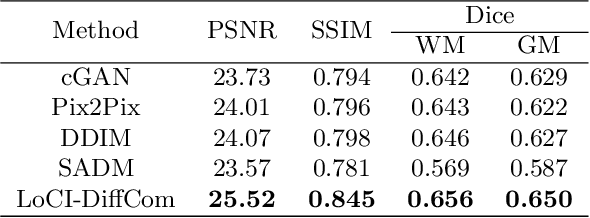
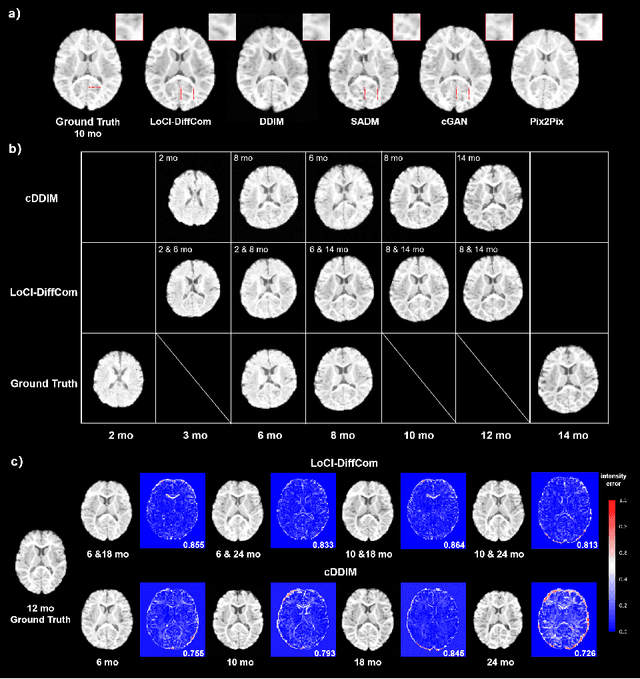
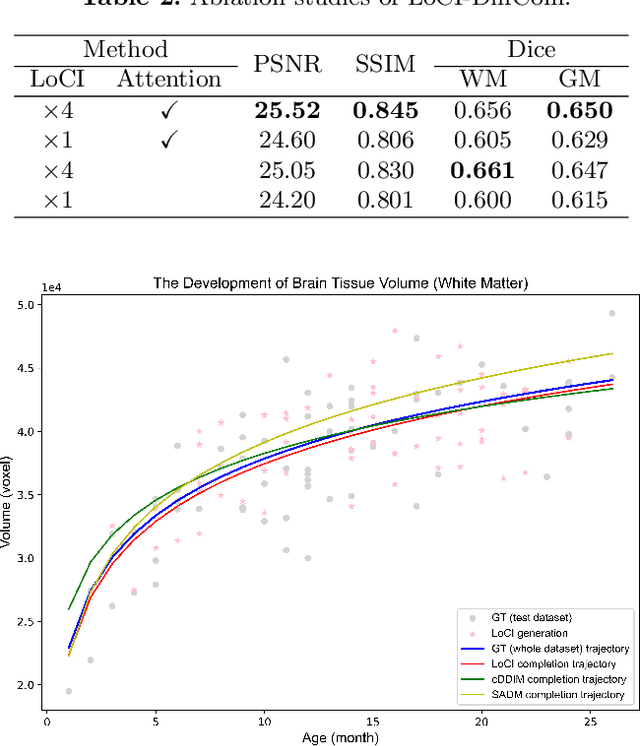
Abstract:The infant brain undergoes rapid development in the first few years after birth.Compared to cross-sectional studies, longitudinal studies can depict the trajectories of infants brain development with higher accuracy, statistical power and flexibility.However, the collection of infant longitudinal magnetic resonance (MR) data suffers a notorious dropout problem, resulting in incomplete datasets with missing time points. This limitation significantly impedes subsequent neuroscience and clinical modeling. Yet, existing deep generative models are facing difficulties in missing brain image completion, due to sparse data and the nonlinear, dramatic contrast/geometric variations in the developing brain. We propose LoCI-DiffCom, a novel Longitudinal Consistency-Informed Diffusion model for infant brain image Completion,which integrates the images from preceding and subsequent time points to guide a diffusion model for generating high-fidelity missing data. Our designed LoCI module can work on highly sparse sequences, relying solely on data from two temporal points. Despite wide separation and diversity between age time points, our approach can extract individualized developmental features while ensuring context-aware consistency. Our experiments on a large infant brain MR dataset demonstrate its effectiveness with consistent performance on missing infant brain MR completion even in big gap scenarios, aiding in better delineation of early developmental trajectories.
Dr.Hair: Reconstructing Scalp-Connected Hair Strands without Pre-training via Differentiable Rendering of Line Segments
Mar 29, 2024Abstract:In the film and gaming industries, achieving a realistic hair appearance typically involves the use of strands originating from the scalp. However, reconstructing these strands from observed surface images of hair presents significant challenges. The difficulty in acquiring Ground Truth (GT) data has led state-of-the-art learning-based methods to rely on pre-training with manually prepared synthetic CG data. This process is not only labor-intensive and costly but also introduces complications due to the domain gap when compared to real-world data. In this study, we propose an optimization-based approach that eliminates the need for pre-training. Our method represents hair strands as line segments growing from the scalp and optimizes them using a novel differentiable rendering algorithm. To robustly optimize a substantial number of slender explicit geometries, we introduce 3D orientation estimation utilizing global optimization, strand initialization based on Laplace's equation, and reparameterization that leverages geometric connectivity and spatial proximity. Unlike existing optimization-based methods, our method is capable of reconstructing internal hair flow in an absolute direction. Our method exhibits robust and accurate inverse rendering, surpassing the quality of existing methods and significantly improving processing speed.
Cas-DiffCom: Cascaded diffusion model for infant longitudinal super-resolution 3D medical image completion
Feb 21, 2024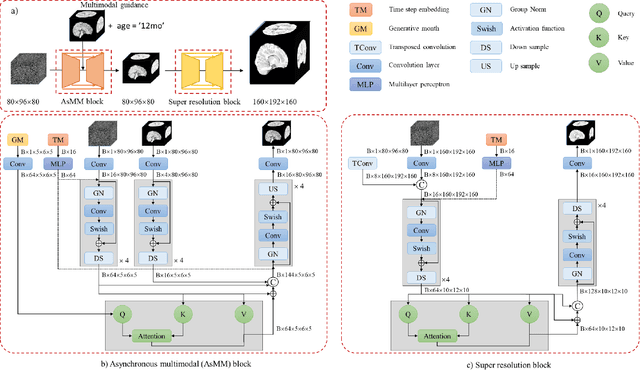

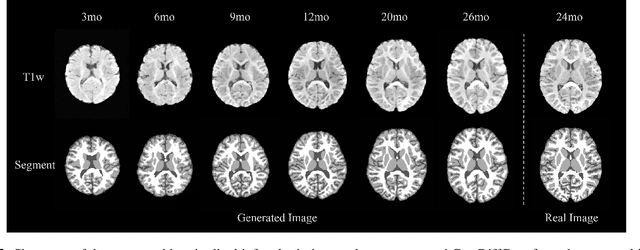

Abstract:Early infancy is a rapid and dynamic neurodevelopmental period for behavior and neurocognition. Longitudinal magnetic resonance imaging (MRI) is an effective tool to investigate such a crucial stage by capturing the developmental trajectories of the brain structures. However, longitudinal MRI acquisition always meets a serious data-missing problem due to participant dropout and failed scans, making longitudinal infant brain atlas construction and developmental trajectory delineation quite challenging. Thanks to the development of an AI-based generative model, neuroimage completion has become a powerful technique to retain as much available data as possible. However, current image completion methods usually suffer from inconsistency within each individual subject in the time dimension, compromising the overall quality. To solve this problem, our paper proposed a two-stage cascaded diffusion model, Cas-DiffCom, for dense and longitudinal 3D infant brain MRI completion and super-resolution. We applied our proposed method to the Baby Connectome Project (BCP) dataset. The experiment results validate that Cas-DiffCom achieves both individual consistency and high fidelity in longitudinal infant brain image completion. We further applied the generated infant brain images to two downstream tasks, brain tissue segmentation and developmental trajectory delineation, to declare its task-oriented potential in the neuroscience field.
BackdoorBench: A Comprehensive Benchmark and Analysis of Backdoor Learning
Jan 26, 2024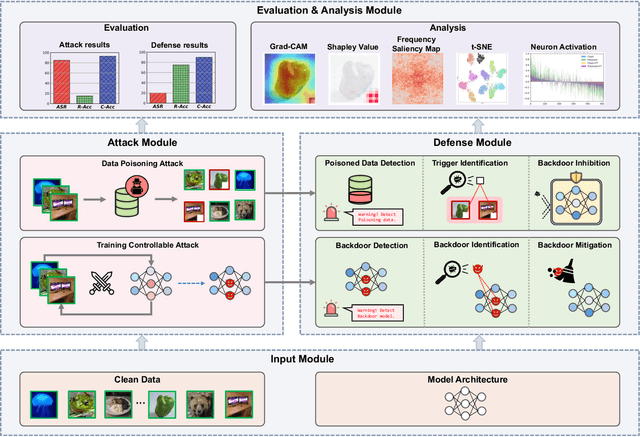
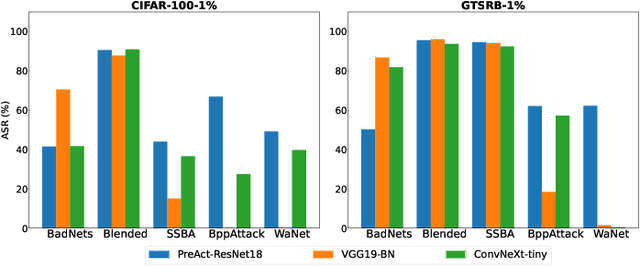
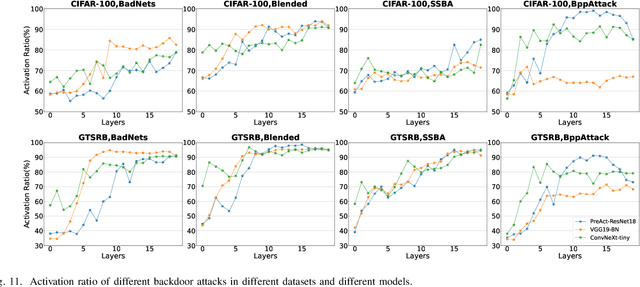

Abstract:As an emerging and vital topic for studying deep neural networks' vulnerability (DNNs), backdoor learning has attracted increasing interest in recent years, and many seminal backdoor attack and defense algorithms are being developed successively or concurrently, in the status of a rapid arms race. However, mainly due to the diverse settings, and the difficulties of implementation and reproducibility of existing works, there is a lack of a unified and standardized benchmark of backdoor learning, causing unfair comparisons, and unreliable conclusions (e.g., misleading, biased or even false conclusions). Consequently, it is difficult to evaluate the current progress and design the future development roadmap of this literature. To alleviate this dilemma, we build a comprehensive benchmark of backdoor learning called BackdoorBench. Our benchmark makes three valuable contributions to the research community. 1) We provide an integrated implementation of state-of-the-art (SOTA) backdoor learning algorithms (currently including 16 attack and 27 defense algorithms), based on an extensible modular-based codebase. 2) We conduct comprehensive evaluations of 12 attacks against 16 defenses, with 5 poisoning ratios, based on 4 models and 4 datasets, thus 11,492 pairs of evaluations in total. 3) Based on above evaluations, we present abundant analysis from 8 perspectives via 18 useful analysis tools, and provide several inspiring insights about backdoor learning. We hope that our efforts could build a solid foundation of backdoor learning to facilitate researchers to investigate existing algorithms, develop more innovative algorithms, and explore the intrinsic mechanism of backdoor learning. Finally, we have created a user-friendly website at http://backdoorbench.com, which collects all important information of BackdoorBench, including codebase, docs, leaderboard, and model Zoo.
Enhanced Few-Shot Class-Incremental Learning via Ensemble Models
Jan 14, 2024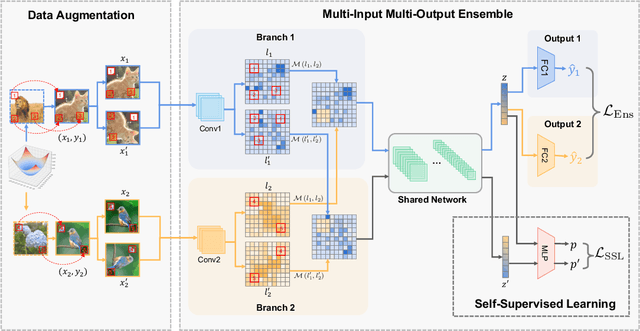
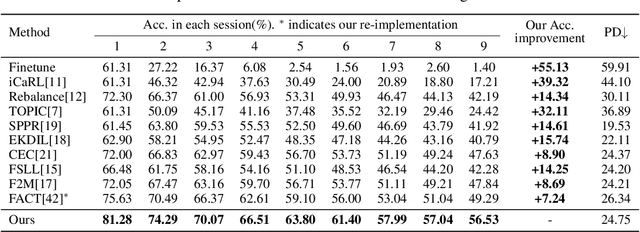
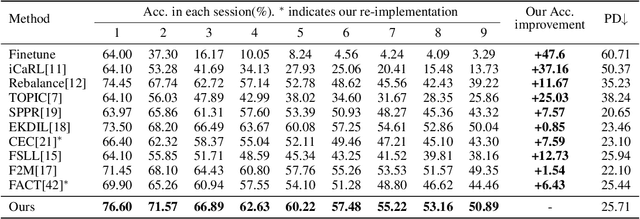

Abstract:Few-shot class-incremental learning (FSCIL) aims to continually fit new classes with limited training data, while maintaining the performance of previously learned classes. The main challenges are overfitting the rare new training samples and forgetting old classes. While catastrophic forgetting has been extensively studied, the overfitting problem has attracted less attention in FSCIL. To tackle overfitting challenge, we design a new ensemble model framework cooperated with data augmentation to boost generalization. In this way, the enhanced model works as a library storing abundant features to guarantee fast adaptation to downstream tasks. Specifically, the multi-input multi-output ensemble structure is applied with a spatial-aware data augmentation strategy, aiming at diversifying the feature extractor and alleviating overfitting in incremental sessions. Moreover, self-supervised learning is also integrated to further improve the model generalization. Comprehensive experimental results show that the proposed method can indeed mitigate the overfitting problem in FSCIL, and outperform the state-of-the-art methods.
 Add to Chrome
Add to Chrome Add to Firefox
Add to Firefox Add to Edge
Add to Edge